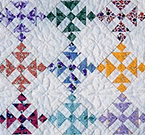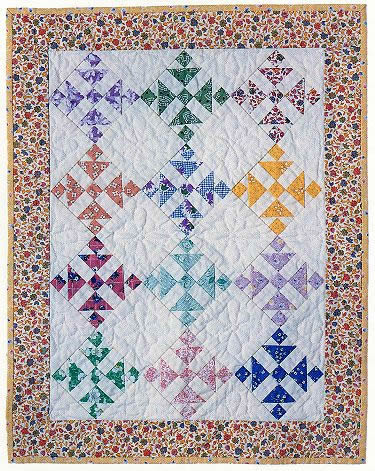|
|

•
•
•
•
•
•
•
•
•
•
•
•
•
•
•
•
•
•
•
•
•
•
•
•
•

|
|


I chose this picture of a quilt to represent my views on multicultural education for a number of reasons. First, when somebody looks at a quilt, he or she has a set of pre-conceived notions about the type of person who made it — probably that person is older, gray-haired, light-skinned, and female. This is how my students feel when they look at me, I have no doubt. My outward appearance screams, “White, middle-class girl,” which roughly translates in student-ese to mean “clueless, unreachable, and disinterested in me.” However, I hope that upon further inspection my students find intricacies where they once saw only a very basic tapestry and colorful passion where they saw only white space. Second, by nature, quilts are patched together out of pieces of various fabrics of many colors, shapes, sizes, patterns, and textures. I love to travel and understand pieces of different cultures, and I have learned the value of gaining the same types of knowledge through conversations with my students and their families. While I will never be so bold or assuming as to say that I am made up of all of these multicultural aspects, I do hope that I am able to represent well each of the communities I belong to and reach out to those I am still somewhat clueless toward. Banks’ article points out the need for teacher education to achieve success in multicultural education. I hope to continue to learn about the types of students in my class from the students, their families, and community resources. In this way, my quilt is a picture of what my goal will always be. The third reason I chose a picture of a quilt is because of its practicality. Sure, it is classic and maybe even antique, and most people of my generation and certainly my students’ generation would never choose to display a quilt in their home, but no one can deny the comfort and warmth they provide. This is how the idealistic side of me hopes that my classroom is for every student who enters it. I want the environment of the room and the culture of the classes to be one that is open, inclusive, accepting, and all-around loving. Students need an environment and a classroom system, including instruction and assessment, that promotes multiculturalism in order to learn, for if they do not feel accepted and supported, it is unlikely any student will be motivated to put forth effort toward learning. While there is little that any one teacher can do about the way schools and school districts are run, each of us does have an opportunity to advocate to those governing our schools for our students and for an environment that will support them wherever we are. Banks talks about the need for sweeping changes to be made from the top down to improve intergroup relations. This is where professional teachers have a responsibility to work for change and work toward multiculturalism in our schools. Whole school systems need an organizational structure and a governing body that fights for each of its students. The picture of a quilt is important here, too, as each quilt that is made is an intense labor of love. It takes time, effort, and often pain, to craft something so beautiful and practical. These are the qualities required of professionals who intend to advocate for multiculturalism in education. The picture of a quit that I have chosen to represent my views on multicultural education is a representation of the way that classroom discussion operates in my classroom to implement the principles Banks sets forth for how schools must promote intergroup relations. We should ensure effective and sensitive communication with all learners, which allows us to not only exist together, but also to thrive together and actually produce something that is more useful and productive than if we existed separately. The same is true of the quilt in my picture. Each of the pieces of fabric serves a purpose individually, but together they are much more aesthetically pleasing and also provide more warmth. January, 2009 Article Reference Banks, James A. Diversity within unity: Essential principles for teaching and learning in a multicultural society. New Horizons for Learning, Online. April, 2001. http://www.newhorizons.org
For a printer-friendly copy
For a printer-friendly copy
|
|
|


